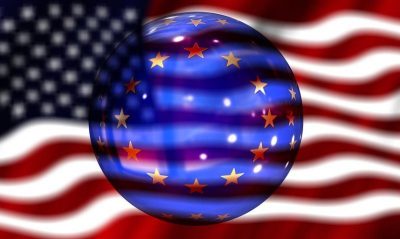
Donald Trump’s expected return to the White House in January has been met with intense skepticism by Europe’s political and economic elites. The continent’s markets have trended lower, and the euro has fallen to its worst mark against the US dollar since the 2022 energy crisis. The cause is directly related to fears that Trump will fulfil his campaign promises to impose 10-20% cross-border tariffs on all foreign imports, including those from Europe.
Barclays analysts cited by the Financial Times pointed to the poor performance of the Stoxx Europe 600 (which measures the performance of the European market) compared to US markets — which soared on the news of Trump’s re-election last week.
ING’s head of global markets, Chris Turner, explained the situation in no uncertain terms:
“Investors fear that Europe will be in the front line of the coming trade war.”
“In the absence of European fiscal stimulus, it looks like the support is going to have to come from the ECB,” he added.
According to Markus Hansen, a portfolio manager at Vontobel, a Zurich-based investment management firm,
“Trump’s not messing around. His administration wants to get going on tariffs from day one,” and European companies “will find themselves in the crossfire.”

Image is from the Public Domain
The president-elect appeared to confirm his reported plans to rehire famed trade hawk Robert Lighthizer as his Treasury secretary last week. During Trump’s first term, Lighthizer started a trade war with China, forced Canada and Mexico to renegotiate the North American Free Trade Agreement (NAFTA), and slapped tariffs of up to 25 percent on steel and 10 percent on aluminum imports from much of the world, including Europe.
The FT reported that the spectre of new Trump tariffs and China’s growing industrial might push European manufacturers deeper into crisis, which are already reeling from Brussels’ short-sighted decision in 2022 to try to wean off cheap Russian energy, which has pushed regional industrial powers into recession and arguably the worst deindustrialization crisis since the Second World War.
Chief European economist at Jefferies, Mohit Kumar, confirmed to the FT that Europe’s poor performance was linked to the fact that its “cheap energy model has been broken” by the Ukraine crisis.
The reaction of the market and business community to Trump’s victory echoed a number of pessimistic analyses about Europe’s prospects under the soon-to-be president in general. According to Fortune, the president-elect is expected to test European solidarity on NATO, Ukraine and trade, which will prove “‘tariff man’ Trump could be 2025’s disaster” for a Germany lurching “from crisis to crisis.”
Representatives of Europe’s political class could not help but express disdain for Trump following his election. EU foreign policy chief Josep Borrell told colleagues in Brussels that Trump’s victory “is going to have many geopolitical consequences.”
“We must not show that we are frightened or divided – although in reality we certainly are, because the reception of President Trump’s victory has not been the same in one capital as in another. In any case, this will also have profound consequences for our bilateral relations. Trump talks about imposing 10% customs duties on all European products. If such a thing were to happen, it would certainly affect our competitiveness,” he added.
China is the EU’s third-largest trading partner, accounting for nearly 9% of exports, and any trade war will only further weaken the European economy.
“European automakers such as Volkswagen and Mercedes and luxury groups including LVMH — already wrestling with weak demand from China — are particularly sensitive to US-China tariffs, while wind power companies like Ørsted and Vestas have been hit hard by Trump’s pledge to scrap renewables projects,” FT reported.
European industrial woes are also affecting the euro, which has slumped to its lowest level in a year at around $1.05 – its sharpest drop since the 2022 energy crisis. The euro-dollar pair weakened significantly after Trump won the presidential election, with the US dollar soaring more than 3% against the euro.
A 20 percent tariff on all $3 trillion worth of US imports would violate Washington’s tariff commitments in the WTO and account for about $575 billion worth of cars, pharmaceutical products, and machinery, among many other products from the EU.
Everett Eissenstat, who was deputy assistant to the president for international economic affairs during the early years of the first Trump administration, warned that European leaders should not assume that Trump’s tariff threats are “just a bluff, or that it’s not going to happen” and stressed that “the president has been pretty consistent in doing what he says he’s going to do, and the team he’s building is built for this.”
Most of Europe was in denial that Trump would easily overcome Kamala Harris and return to the White House. Now, there is a great scramble to figure out how to deal with Trump once he comes to power in January 2021.
In effect, the EU, for the first time since the Biden administration took power in Washington, will have to deal with reality and not delusions and faux moralism that has dominated European policy and trapped the bloc into the Ukraine quagmire that the president-elect will withdraw the US from, leaving Europe with an immense mess.
*
Click the share button below to email/forward this article to your friends and colleagues. Follow us on Instagram and Twitter and subscribe to our Telegram Channel. Feel free to repost and share widely Global Research articles.
Don’t Miss Out on Global Research Online e-Books!
This article was originally published on InfoBrics.
Ahmed Adel is a Cairo-based geopolitics and political economy researcher. He is a regular contributor to Global Research.
Featured image is from Strategic Culture Foundation
Comment on Global Research Articles on our Facebook page
Become a Member of Global Research
Source link

